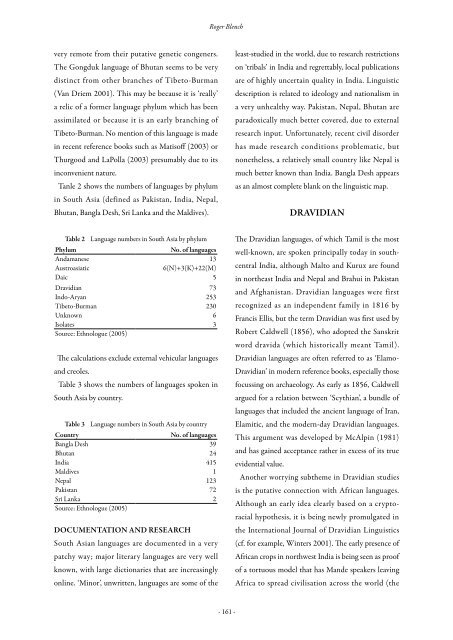Re-evaluating the linguistic prehistory of South Asia - Roger Blench
Re-evaluating the linguistic prehistory of South Asia - Roger Blench
Re-evaluating the linguistic prehistory of South Asia - Roger Blench
Create successful ePaper yourself
Turn your PDF publications into a flip-book with our unique Google optimized e-Paper software.
<strong>Roger</strong> <strong>Blench</strong><br />
very remote from <strong>the</strong>ir putative genetic congeners.<br />
The Gongduk language <strong>of</strong> Bhutan seems to be very<br />
distinct from o<strong>the</strong>r branches <strong>of</strong> Tibeto-Burman<br />
(Van Driem 2001). This may be because it is ‘really’<br />
a relic <strong>of</strong> a former language phylum which has been<br />
assimilated or because it is an early branching <strong>of</strong><br />
Tibeto-Burman. No mention <strong>of</strong> this language is made<br />
in recent reference books such as Matis<strong>of</strong>f (2003) or<br />
Thurgood and LaPolla (2003) presumably due to its<br />
inconvenient nature.<br />
Tanle 2 shows <strong>the</strong> numbers <strong>of</strong> languages by phylum<br />
in <strong>South</strong> <strong>Asia</strong> (defined as Pakistan, India, Nepal,<br />
Bhutan, Bangla Desh, Sri Lanka and <strong>the</strong> Maldives).<br />
least-studied in <strong>the</strong> world, due to research restrictions<br />
on ‘tribals’ in India and regrettably, local publications<br />
are <strong>of</strong> highly uncertain quality in India. Linguistic<br />
description is related to ideology and nationalism in<br />
a very unhealthy way. Pakistan, Nepal, Bhutan are<br />
paradoxically much better covered, due to external<br />
research input. Unfortunately, recent civil disorder<br />
has made research conditions problematic, but<br />
none<strong>the</strong>less, a relatively small country like Nepal is<br />
much better known than India. Bangla Desh appears<br />
as an almost complete blank on <strong>the</strong> <strong>linguistic</strong> map.<br />
DRAVIDIAN<br />
Table 2 Language numbers in <strong>South</strong> <strong>Asia</strong> by phylum<br />
Phylum<br />
No. <strong>of</strong> languages<br />
Andamanese 13<br />
Austroasiatic<br />
6(N)+3(K)+22(M)<br />
Daic 5<br />
Dravidian 73<br />
Indo-Aryan 253<br />
Tibeto-Burman 230<br />
Unknown 6<br />
Isolates 3<br />
Source: Ethnologue (2005)<br />
The calculations exclude external vehicular languages<br />
and creoles.<br />
Table 3 shows <strong>the</strong> numbers <strong>of</strong> languages spoken in<br />
<strong>South</strong> <strong>Asia</strong> by country.<br />
Table 3 Language numbers in <strong>South</strong> <strong>Asia</strong> by country<br />
Country<br />
No. <strong>of</strong> languages<br />
Bangla Desh 39<br />
Bhutan 24<br />
India 415<br />
Maldives 1<br />
Nepal 123<br />
Pakistan 72<br />
Sri Lanka 2<br />
Source: Ethnologue (2005)<br />
DOCUMENTATION AND RESEARCH<br />
<strong>South</strong> <strong>Asia</strong>n languages are documented in a very<br />
patchy way; major literary languages are very well<br />
known, with large dictionaries that are increasingly<br />
online. ‘Minor’, unwritten, languages are some <strong>of</strong> <strong>the</strong><br />
The Dravidian languages, <strong>of</strong> which Tamil is <strong>the</strong> most<br />
well-known, are spoken principally today in southcentral<br />
India, although Malto and Kurux are found<br />
in nor<strong>the</strong>ast India and Nepal and Brahui in Pakistan<br />
and Afghanistan. Dravidian languages were first<br />
recognized as an independent family in 1816 by<br />
Francis Ellis, but <strong>the</strong> term Dravidian was first used by<br />
Robert Caldwell (1856), who adopted <strong>the</strong> Sanskrit<br />
word dravida (which historically meant Tamil).<br />
Dravidian languages are <strong>of</strong>ten referred to as ‘Elamo-<br />
Dravidian’ in modern reference books, especially those<br />
focussing on archaeology. As early as 1856, Caldwell<br />
argued for a relation between ‘Scythian’, a bundle <strong>of</strong><br />
languages that included <strong>the</strong> ancient language <strong>of</strong> Iran,<br />
Elamitic, and <strong>the</strong> modern-day Dravidian languages.<br />
This argument was developed by McAlpin (1981)<br />
and has gained acceptance ra<strong>the</strong>r in excess <strong>of</strong> its true<br />
evidential value.<br />
Ano<strong>the</strong>r worrying sub<strong>the</strong>me in Dravidian studies<br />
is <strong>the</strong> putative connection with African languages.<br />
Although an early idea clearly based on a cryptoracial<br />
hypo<strong>the</strong>sis, it is being newly promulgated in<br />
<strong>the</strong> International Journal <strong>of</strong> Dravidian Linguistics<br />
(cf. for example, Winters 2001). The early presence <strong>of</strong><br />
African crops in northwest India is being seen as pro<strong>of</strong><br />
<strong>of</strong> a tortuous model that has Mande speakers leaving<br />
Africa to spread civilisation across <strong>the</strong> world (<strong>the</strong><br />
- 161 -

















